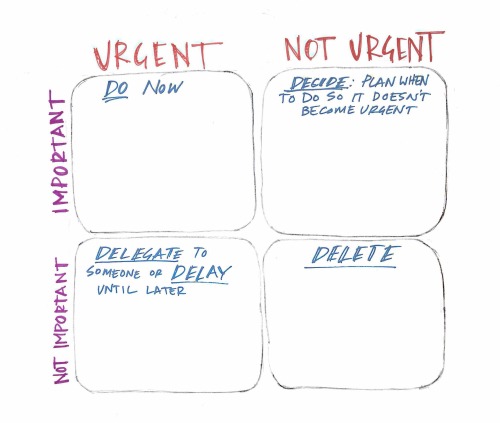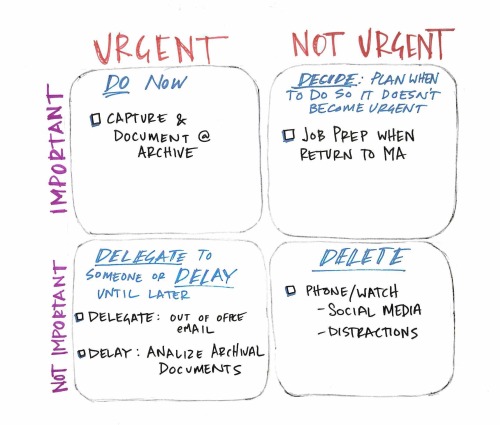The word “doozy” gets a bad reputation.
We use it to emphasize the scope of things that tax our energy, as in Whoa, that 3-hour meeting was a doozy or That final exam was a doozy; I hope I did okay.
But the actual definition for doozy is “something very good of its kind.” Its synonyms include words like beaut, crackerjack, dream, honey, knockout, nifty, and standout. So, we could just as easily perceive doozies as thrilling and exciting opportunities.
Why the vocabulary lesson in a post about Priority Setting? Well, August is going to be a doozy of a productive month for me, and I want to set myself up to have a honey crackerjack dream experience rather than a stressful freakout of a time. In order to manifest the good kind of doozy, I absolutely need to learn how to prioritize (which means you get to learn, too!).
What Is a Priority?
A priority is a thing that receives our immediate attention. When we make one thing a priority, we choose to put other, less important things on the back burner for the time being. Our priorities may shift depending on what’s going on in our life, but whatever our priority is will always take precedence over other tasks or requirements.
There are three things to know about priorities:
- Only you will know what your priorities are.
- Your priorities don’t have to mirror the priorities of others.
- Your priorities will—and should—change and shift. Be open to this!
But What If Everything Feels Like a Priority?
I hear you, and I get it.
I also want to do everything and to do them all extremely well.
But, because multitasking is really just task switching and because we have limited amounts of time, energy, and focus, we can benefit from systems that help us to identify and manage our priorities. One key way to do this is by recognizing how important and urgent particular tasks really are. Luckily, there’s a tool to help us.
The Eisenhower Matrix
Productivity scholarship often refers to the Eisenhower principle, which got its name from former U.S. President Eisenhower, who said, “I have two kinds of problems, the urgent and the important. The urgent are not important, and the important are never urgent.”
This principle was developed into a visual matrix for determining priorities—or those tasks that are both important and urgent.
According to Mind Tools, a management and leadership training agency, differentiating urgent and important tasks can help us “overcome the natural tendency to focus on unimportant urgent activities, so that we can clear enough time to do what’s essential for our success.”
In other words, priorities are particularly important for people pleasers and those who have a hard time saying no when people ask us to help (raising my hand here, too)!
Here is a visual representation of the Eisenhower matrix with action words that coordinate with each quadrant:

(thanks to my Sweetie for drawing this up!)

I have two takeaways for you this week. First, I’ll show you how to fill out an Eisenhower matrix and then I’ll share a practical tip for all of my fellow perfectionists out there!
Set and Visualize Your Priorities
I use a personal example below to show you how to identify what goes in the quadrants of your Eisenhower matrix. Once you read it through, use my description as a model for determining your own DO, DECIDE, DELEGATE/DELAY, and DELETE boxes.
This coming week I’ll be at the ONE Archives in Los Angeles on a research fellowship, so my #1 priority will be to work with the materials in the archive.
Because I only have a limited amount of time in the archive, I will not be focused on analyzing the materials (DELAY); instead I’ll focus on capturing and documenting them (DO). To truly prioritize working the archive, I will wait to do job prep for my new tutor position until I return to Massachusetts (DECIDE), and I have also put up an automatic out of office response on my work email (DELEGATE). Finally, I’ll eliminate unnecessary distraction by putting my phone and watch on silent (DELETE).
Here’s how I would map that out in an Eisenhower matrix:

Perfect is the Enemy of Good: Set a Timer
I recently had a coaching call with Allison Graham, who I learned about on the Burnt Out podcast in the RESILIENCE episode. One particularly helpful tip that Allison shared is to use a timer for those tasks that we tend to spend way too much time perfecting when simply “good enough” will do.
For example, I was spending way too much time designing and tweaking each intro image for my blog posts… like, probably an hour total spread out throughout the week. Allison suggested that I limit myself to ten minutes by setting a timer for 9 minutes to work on designing my image in Canva and then use the remaining 1 minute to finish up. I felt a sense of glee: a professional business and life coach was giving me permission to just do my best and put it out into the world! It made so much sense, because spending those extra 30+ minutes didn’t actually produce a better image, it just gave me more time to hem and haw about fonts until I feel stressed out.
This feels different from a Pomodoro session, where I would be slowly working on one big task across chunks of time. Instead, using a short timer helps me to finish up small tasks and say “this is good enough!” rather than wasting time tweaking and “perfecting.”
*Please note that the original version of this blog post was published here.
This blog is not affiliated with, associated with, or endorsed by the Pomodoro Technique® or Francesco Cirillo.
Newsletter
Sign up below to access my free newsletter, Tending with Dr. Kate Henry.

